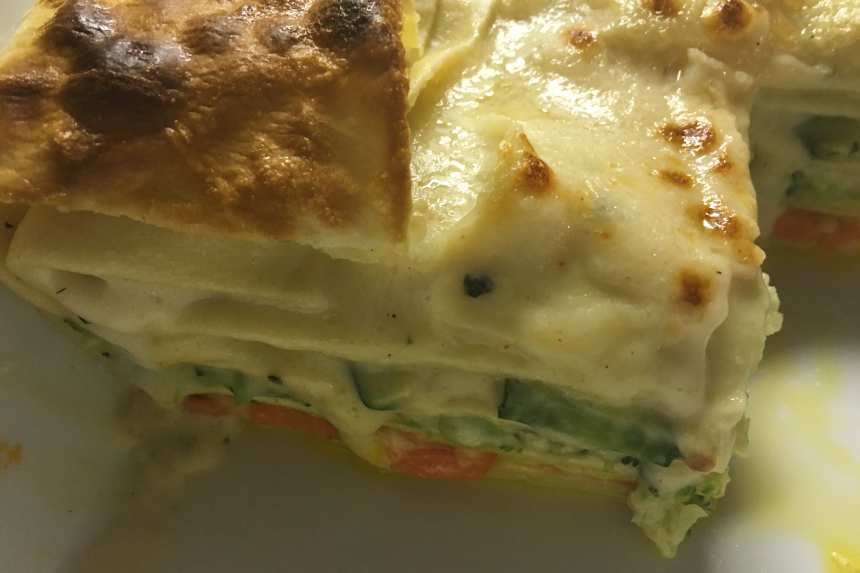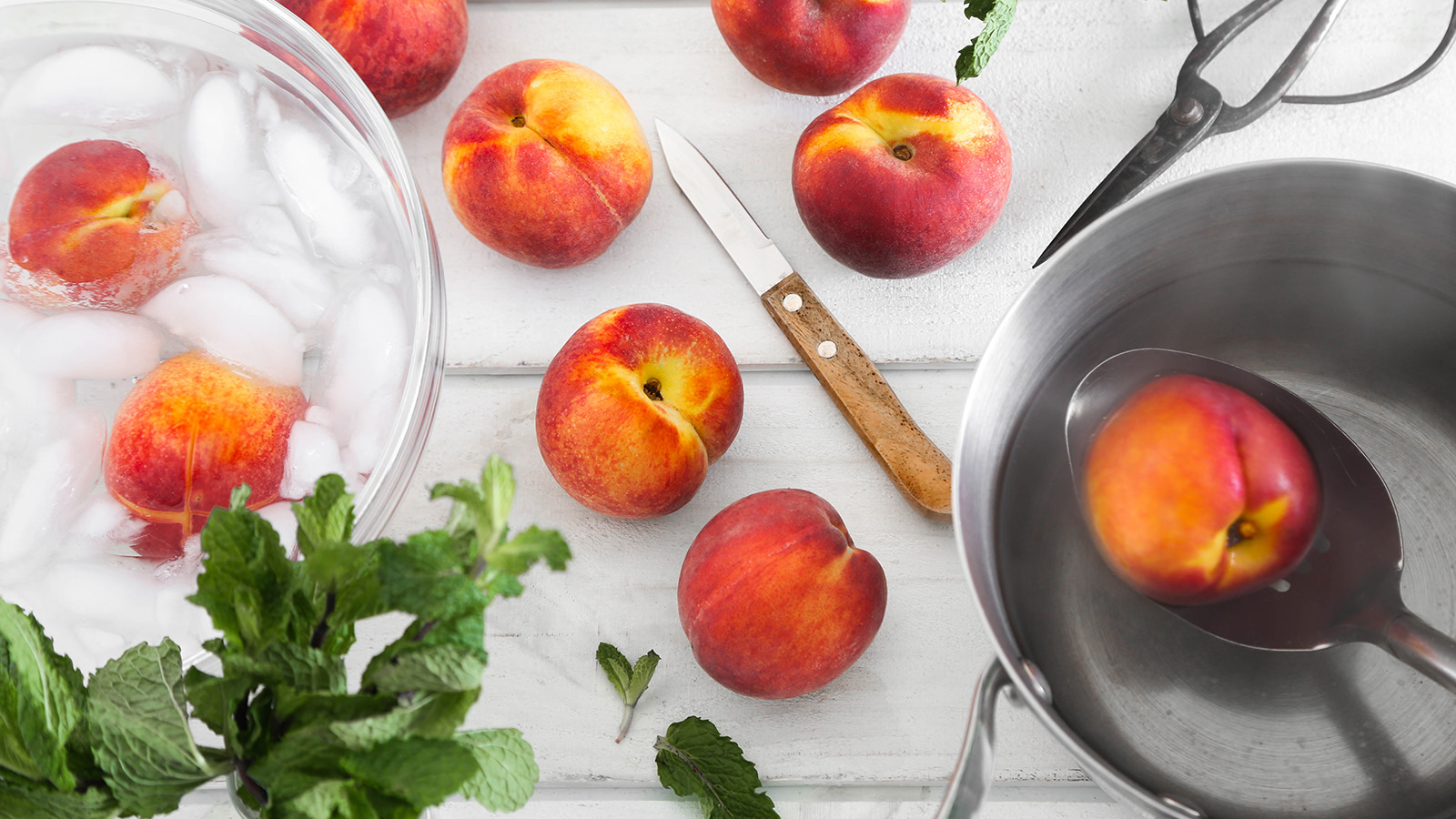Vegetable Lasanga

photo by Tuck Burnette

- Ready In:
- 4hrs 45mins
- Ingredients:
- 22
- Yields:
-
1 13x9 Lasanga
- Serves:
- 10
ingredients
- 3 cups all-purpose unbleached wheat flour
- 2 pinches salt
- 1 tablespoon vital wheat gluten
- 5 large eggs, at room temperature
- 1 cup flour
- 4 tablespoons butter, cut up
- 1⁄3 cup all-purpose flour
- salt
- pepper
- nutmeg, grated
- 1 pinch cayenne pepper
- 3 cups milk, cold
- splash heavy cream or half-and-half
- 6 ounces parmigiano-reggiano cheese, rind removed
- 1⁄2 cup unsalted butter
- 8 large garlic cloves, peeled
- 4 tablespoons olive oil, divided
- 12 -14 ounces young carrots
- 1 lb zucchini
- 1 lb broccoli, crown
- 1⁄2 cup water, approximately
- shortening, for the pan
directions
- Make pasta: Put flour, salt, and gluten into the bowl of a stand mixer. Crack eggs into a bowl and add to flour all at once. Fit with the hook attachment and work at speed 3 or 4, for about five minutes, or until a cohesive dough comes together. Reduce to 2 speed, and knead in machine for about 8 minutes.
- Put about 1 cup flour into a clean mixing bowl, dredge dough lightly on both sides, tamp, and then fit into a gallon size bag to rest for 30 minutes. Set the bowl of flour aside, you will need it later.
- Make the white sauce: Melt butter gently, in a 6-cup saucepan, or its equivalent. Add the flour (1/3 cup), and the salt, pepper, and seasonings. Cook for about two minutes. Pour in the milk, and cream, all at once, increase the heat of the pan to medium-high, and stir with a whisk, while it comes to a boil. Remove from heat. Grate in some cheese. Check for salt. Remove 1/2 cup of it and cover. Divide remaining sauce evenly between three bowls, that can later accommodate each vegetable separately. Set aside.
- Make the garlic butter: Melt the butter in an 8-inch skillet over medium low heat, adding the garlic cloves, each crushed into a few pieces. Add 2 tablespoons of the oil. Simmer lazily for 5-8 minutes. Remove from heat and strain into a 1-cup glass measure, or a 1-cup metal measuring cup, pressing on the garlic cloves lightly. The mixture will be divided into thirds to sauté the vegetables. The garlic cloves may sit in the butter for a while, if desired.
- Prepare the vegetables and keep them separated: peel and slice the carrots into thin rounds, no thicker than 1/4 inch, discarding both ends. Slice the zucchini exactly the same, 1/8-1/4 inch thick, discarding both ends. Pull all of the flowerets off of the broccoli crown, discarding the central core. Chop them fine, do this by cutting two or more slices, lengthwise down each stem of broccoli, as if beginning to dice an onion, then work the knife through it rapidly, chopping, through the flowery head, which will easily subside.
- Sauté the vegetables: Heat a 12-inch lidded sauté pan. Put in two or three tablespoons of the water, the carrots, and some salt. Increase the heat and add one third of the strained butter, cook, stirring often, until the carrots decrease in volume. Cover the pan, lower the heat, checking from time to time, and cook for about 8 minutes. The carrots should be fully cooked, and offer minimal resistance to the tooth, they should not be al dente, and will not continue to cook, in the lasagna.
- Place the carrots, and all the contents of the pan, into one of the bowls containing the white sauce, stir well, cover, and set aside.
- Return the pan to medium heat. Put in half of the remaining butter, and the zucchini, season with salt, and increase the heat, if desired. Stir often, separating the zucchini rounds as necessary, when a fond develops on the bottom of the pan, add two tablespoons of the water, to deglaze, cook the zucchini, just until they are done, they will cook faster than the other two vegetable, if they stick together, separate pieces with a dinner knife and fork. Pour them into the second bowl of Béchamel, stir, cover and set aside.
- Return the pan to medium heat. Add the remaining butter and the remaining oil (the broccoli really soaks it up) and slip in the broccoli, some salt, and the remaining two or three tablespoons of water. Cover the pan, and cook for a few minutes. Remove the lid, increase the heat, and simmer for a few minutes to evaporate any moisture. The broccoli should be fully cooked. Turn into the past pot of Béchamel, stir, cover, and set aside.
- Get a pot of water boiling with salt in it.
- Roll the pasta: Fit the mixer with the pasta rolling attachment. Retrieve the pasta and cut into eight equal pieces. Retrieve the bowl of flour. Sprinkle some lightly on a clean sheet pan. Keep the bowl handy. Run each piece of pasta dough through on the largest setting. Dredge each side of dough into flour as it comes from the machine, so that they can set together without sticking. Run the pasta through again on the next largest setting. Do not keep dredging in flour unless it seems sticky, but it probably won't. Run each pasta sheet through the machine, until reaching a setting of 5, or at most, 6, not more, or the cooking method will have to be changed. Do not trim the pasta.
- Blanch each piece of pasta in the simmering water for, in two batches, for about two or at most three minutes, it is possible that it could take less. The pasta should be very al dente, but edible. Retrieve with a pair of tongs lightly into a sieve, set over a bowl, run cold water over it continually, until it is not hot anymore. Have a large mixing bowl or basin handy, where they can be collected, after being retrieved from the running water. Do not dry them. Do this with all pasta sheets, it is okay to work in small batches, as long as you feel comfortable in the cooking process. Do not overcook them.
- Grease a rather deep 13x9 inch pan with a tablespoon of shortening, or softened butter. Put 1 pasta sheet into the pan. Add another, overlapping by no more than 1-inch. Use the sharpest, rather small knife that you can get, a paring knife or fillet knife will do. Trim the edges and sides up the pasta, allowing it to travel about 1/2-1-inch up the sides of the pan, so that it builds up a nice edge, and also a barrier for the filling to rest inches Add one of the fillings (I do carrots first, then zucchini, then broccoli, but you can do any order that you will), smooth the filling, then grate over Parmesan (you need Parm for each layer and the top, so work with that way for now). Do the same procedure to the pasta and filling for each layer, I press the pasta on the previously laid filling before adding the next. There will be pasta left over. If preferred, the filling can be laid (each time), before the pasta is trimmed around the edge.
- Lay on and cut the final layers of pasta, being cautious that it does not expose the filling from underneath. Spread the reserved 1/2 cup sauce evenly and dot with a thick layer of cheese. It is a good idea to grate the cheese all at once into a bowl before doing this because some of it will inevitably fall out of the pan if using a grater directly over the filling. You don't have to.
- Bake the lasagna uncovered on the middle level of a heated 375 degree oven for 25 or 28 minutes. Remove. Preheat the broiler. Glaze for two or three minutes. Rest 5.
Questions & Replies
Got a question?
Share it with the community!
Reviews
Have any thoughts about this recipe?
Share it with the community!
RECIPE SUBMITTED BY
Tuck Burnette
Williamsburg, Virginia




